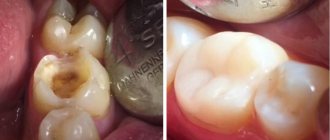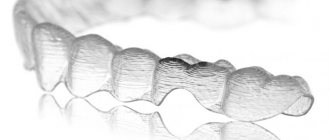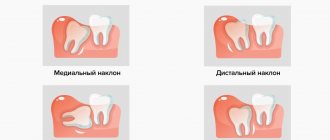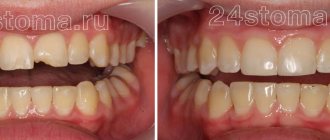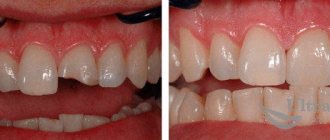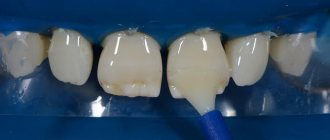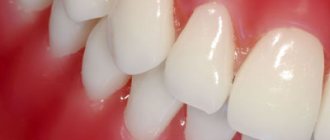Dental restoration is a dental service that allows you to completely restore the shape, function and aesthetic appearance of a tooth destroyed by pathological processes. A variety of technologies and materials can be used to carry out restoration work: photopolymer (light-composite) fillings, veneers, inlays. In this article we will tell you in detail about existing methods of dental restoration, consider their features and prices for the service in Moscow dentists.
Calculate the cost of treatment by taking a short test in 20 seconds!
Do not delay your treatment, because in this matter time plays against us.
Basic methods of dental restoration
Dental restoration methods have their own classification and are divided into direct and indirect restoration. Let's break down these definitions.
Direct dental restoration
The technique can also be called composite restoration. Direct technology is called because the dentist carries out all restoration work to restore a destroyed dental unit directly in the patient’s mouth and usually during one appointment. In direct restoration, light-composite filling materials (photopolymer fillings) will be used to recreate the functions and aesthetic appearance of the tooth.
Indirect dental restoration
This method of dental restoration involves the use of a special type of orthopedic structures - veneers.
Veneers are the thinnest plates made from various materials: ceramics, zirconium, porcelain. They are made in a dental laboratory, using impressions previously taken from prepared teeth. Ready-made veneers are glued to dental surfaces with a special compound and the main purpose of microprostheses is to mask aesthetic defects of teeth - chipped enamel, cracks, interdental spaces. Veneers are stronger than composite fillings, but restoration with miniature onlays is not always possible. For example, indirect restoration of teeth with veneers is impossible due to pathological abrasion of tooth enamel.
The most popular method of dental restoration is composite restoration, that is, with conventional dental fillings, and in the next section of the article we will consider in detail all stages of the restoration process using photopolymer materials.
What's the price?
Anesthesia - 450 rub.
Restoration of one tooth costs from 3,500 to 5,500 rubles, depending on the degree of destruction.
If it is necessary to use a pin, it is added to the cost.
The cost of the anchor pin is 1000 rubles.
The cost of using a fiberglass pin is 1,900 rubles.
Veneer installation - from RUB 15,000
Installation of composite veneers - from 12,000 rubles.
The price of the procedure will depend on the materials chosen, as well as the size of the damaged area. The more teeth you need to restore, the higher the cost will be.
You can find out more about prices on our price list page.
Dental restoration using photopolymer composites: stages of the process
Before moving on to the restoration of damaged teeth or units with poor aesthetics, the doctor will definitely conduct a thorough examination of the oral cavity for the presence of dental diseases. Next, the restoration process will be divided into the following stages:
Professional sanitation of the oral cavity
At this stage, the teeth are cleaned of all types of plaque - hard and soft, tartar. Sanitation of the oral cavity is necessary to accurately determine the shade of natural tooth enamel. Based on a certain shade, the dentist will choose the tone of the composite material, which will allow you to obtain the most aesthetic result of dental restoration.
Anesthesia of the restoration area
It is carried out using local anesthetics. Anesthesia is not always necessary, but only in cases where the tooth is severely damaged by caries. The anesthetic is selected individually and allows for tooth restoration without the slightest discomfort for the patient.
Removal of tissues damaged by caries and old fillings
Before carrying out the restoration, the doctor must properly treat the tooth: remove all tissue destroyed by pathological processes, old and unusable fillings.
Moisture insulation is the most important stage in tooth restoration
In order for a tooth restoration to be not only aesthetically pleasing, but also durable, the area where the manipulation is performed must be properly protected not only from saliva, but even from moisture contained in the patient’s breath.
Cotton swabs were previously used for this purpose, but they did not provide reliable moisture protection. In modern clinics, a special latex lining, a rubber dam, is used to perform moisture insulation. Externally, this pad looks like a handkerchief with slits. The rubber dam is tightly stretched over the teeth and prevents moisture in one form or another from entering the area of restoration work. It is advisable that in the process of dental restoration, a specialist uses a rubber dam, since insufficient protection of the restored tooth from moisture is fraught with a number of negative consequences:
- The edges of the photopolymer filling will not adhere to the natural tissues of the tooth with sufficient density, and this is fraught with the formation of a noticeable dark stripe at the border of their contact or the development of caries in this area;
- An installed filling can quickly fall out, since moisture reduces the degree of adhesion (adhesion) of the photopolymer and dentin.
Installation of a pin in the dental canal
A pin is not always installed during dental restoration, but only when a dental unit is destroyed by more than fifty percent and is depulped. Installing a pin allows you to make the restoration as strong as possible and avoid the filling falling out.
Tooth restoration
At the final stage of the treatment process, the doctor performs the actual restoration, that is, restores the shape and aesthetics of the tooth with photopolymer filling material. The restoration is carried out layer by layer and photopolymers of different shades and transparency levels can be used to create layers - this is necessary so that the result of the restoration work has high aesthetics. The restoration is completed by processing the filling with burs, grinding it and sealing it.
Most Frequently Asked Questions
Is missing a tooth just unsightly or harmful to health?
Violation of the integrity of the dentition has many negative consequences for health.
- Due to lack of load, periodontal tissue and bone quickly atrophy. The risk of other pathological processes occurring in them increases.
- Violation of chewing function entails a number of gastrointestinal diseases. Vitamins, microelements and other beneficial nutrients are poorly absorbed. This weakens the immune system and triggers the aging mechanisms of the body.
- The teeth shift, do not close completely, and an incorrect bite is formed. As a result, the functioning of the temporomandibular joint is disrupted. A person is bothered by headaches, poor sleep, and strange “clicks” in the head and neck.
- A person is embarrassed to smile, talk, communicate with other people. As a result, he withdraws into himself, leads a solitary life, and develops depression.
I urgently need to restore a lost tooth in 1 session - what method do you recommend?
Installing a temporary immediate denture (they are often called “butterflies” due to their unique shape) allows you to restore the dentition in an extremely short time. The prosthesis is made from individual impressions directly in the dentist’s office and is immediately fixed using special fasteners.
- It looks very natural and is completely indistinguishable from real teeth.
- Does not require preliminary grinding of adjacent teeth.
- Prevents tooth displacement and bone atrophy.
- Provides chewing function.
- Comfortable to wear and does not injure gums.
- Has a low cost.
- It will serve you for several months and protect the ground tooth while a permanent prosthesis is being made or the implant is being healed.
What material makes teeth look most natural?
At the moment, zirconium dioxide is considered the most aesthetic material. Only a professional can distinguish crowns and bridges made from it from natural teeth. The material has good biocompatibility, high strength and even some antibacterial effect. Thanks to the translucency characteristic of real tooth enamel, zirconium dioxide dentures look exactly like natural teeth.
Complete restoration of the tooth crown
The cost of restoration will be based on the cost of the following consumables and services:
- Preliminary anesthesia - about 450 rubles;
- Moisture insulation with rubber dam - about 700 rubles;
- Photopolymer filling - from 2000 to 5000 rubles (depending on the type of composite, manufacturer’s brand, amount of material needed for restoration;
- Cost of the pin. Pins are produced by different brands and it is better not to save money and choose a more expensive, but at the same time the highest quality product. Prices for heavy-duty fiberglass pins used in restoration start at 2,500 rubles.
USEFUL TO KNOW: Pins are made from different materials, including metal structures. But it is not advisable to use metal pins for restoration carried out in the area of the anterior teeth. The metal will show through the photopolymer filling material and as a result the restored tooth may have an unnatural bluish tint.
By adding up the amounts indicated above, you can calculate the approximate cost of restoring the entire crown part of the tooth. Such a restoration will cost the patient 6,000-7,000 rubles. Please keep in mind that the stated restoration price does not include the cost of preliminary professional teeth cleaning!
Partial restoration of the tooth crown (no more than ½)
To calculate the cost of restoring a tooth that is half destroyed, it is worth subtracting from the amount calculated above the cost of the pin, which is placed to make the filling resistant to mechanical stress. Thus, the price for partial restoration of a tooth crown will be 5,000 rubles.
Restoration of chipped teeth
Restoration of chipped teeth has a minimal price, which is not surprising - the cost of the service excludes the price of the pin, in addition, the consumption of filling material will be significantly lower. Such restoration is offered to dental patients at a price of 2,500 to 3,000 rubles.
How to restore a beautiful smile?
The front teeth include six upper and six lower teeth. Our dentists use all possible methods for their restoration:
- Ceramic or composite inlays,
- Veneers are permanent “onlays” that are attached directly to an imperfect tooth.
- Restoration by filling is called aesthetic or artistic. Photopolymer fillings are used.
Only your attending physician should choose between the presented methods, since each procedure has its own characteristics and contraindications. In addition to the chosen technique, special attention should be paid to the material. The maximum resemblance to real enamel will depend on this.
With the help of artistic restoration, you can restore the front teeth and canines so that no one can distinguish the restored tooth elements from their own, except the dentist.
Dental restoration: a service you shouldn’t skimp on!
The quality of the dental restoration will determine its aesthetics and durability. You can often find reviews online from patients who were dissatisfied with the poor aesthetics of the restoration: the installed filling is clearly visible and the tooth looks unnatural compared to its healthy “neighbors.” The reason for poor aesthetics is the lack of professionalism and experience of the dentist, as well as violation of the rules of restoration.
For high aesthetics of the result of dental restoration, the following three points are of fundamental importance:
1. Correct restoration of the natural shape of the tooth. This is quite complex and painstaking work, requiring from the dentist not only knowledge and experience, but also artistic talent. When working on the restoration of the form, the specialist must accurately recreate the natural fissures, cusps, and surface of the tooth;
2. Accuracy of tooth-colored restoration. The restored tooth should have a color identical to the tone of the adjacent, healthy units in the rows. Photopolymers for fillings are available in a wide variety of shades, and the specialist’s task is not only to choose the optimal color, but also to be able to combine various tones so that the restored dental unit looks as natural as possible. Not every dentist knows how to work with color and, in addition, some specialists do not take into account the fact that the shade of tooth enamel changes from the edge to the neck. If this important point is overlooked during restoration, the restored tooth will stand out against the background of its “neighbors”;
3. Account for transparency. Not only the tone of the tooth enamel changes, but also the degree of its transparency. It is higher at the edge, and therefore, to restore a tooth in this area, it is important to choose a material with the highest possible transparency.
Now you know why, to obtain aesthetic results from dental restoration, you should contact a dental clinic staffed by experienced and competent specialists. Naturally, the price of restoration in such a clinic will be higher, but the result will not make you want to write a negative review! A full range of dental restoration services is offered to you by our dentistry in Moscow - Vanstom (located next to the Baumanskaya metro station)! You can make an appointment at our clinic either by phone or through the feedback form on our website.
Prevention
Constant and proper care will help you keep your teeth safe and sound:
- Use a suitable toothpaste as recommended by your dentist.
- Brush your teeth at least 2 times a day: morning and evening.
- If you have problems with your gums, hypersensitivity or lack of calcium, you should follow the recommendations of your dentist.
- Tartar should be cleaned every 6 months - this will keep the gums and enamel as healthy as possible, and also get rid of yellow plaque from coffee, tea and nicotine.
- Remember to visit your dentist at least once every three to six months.
